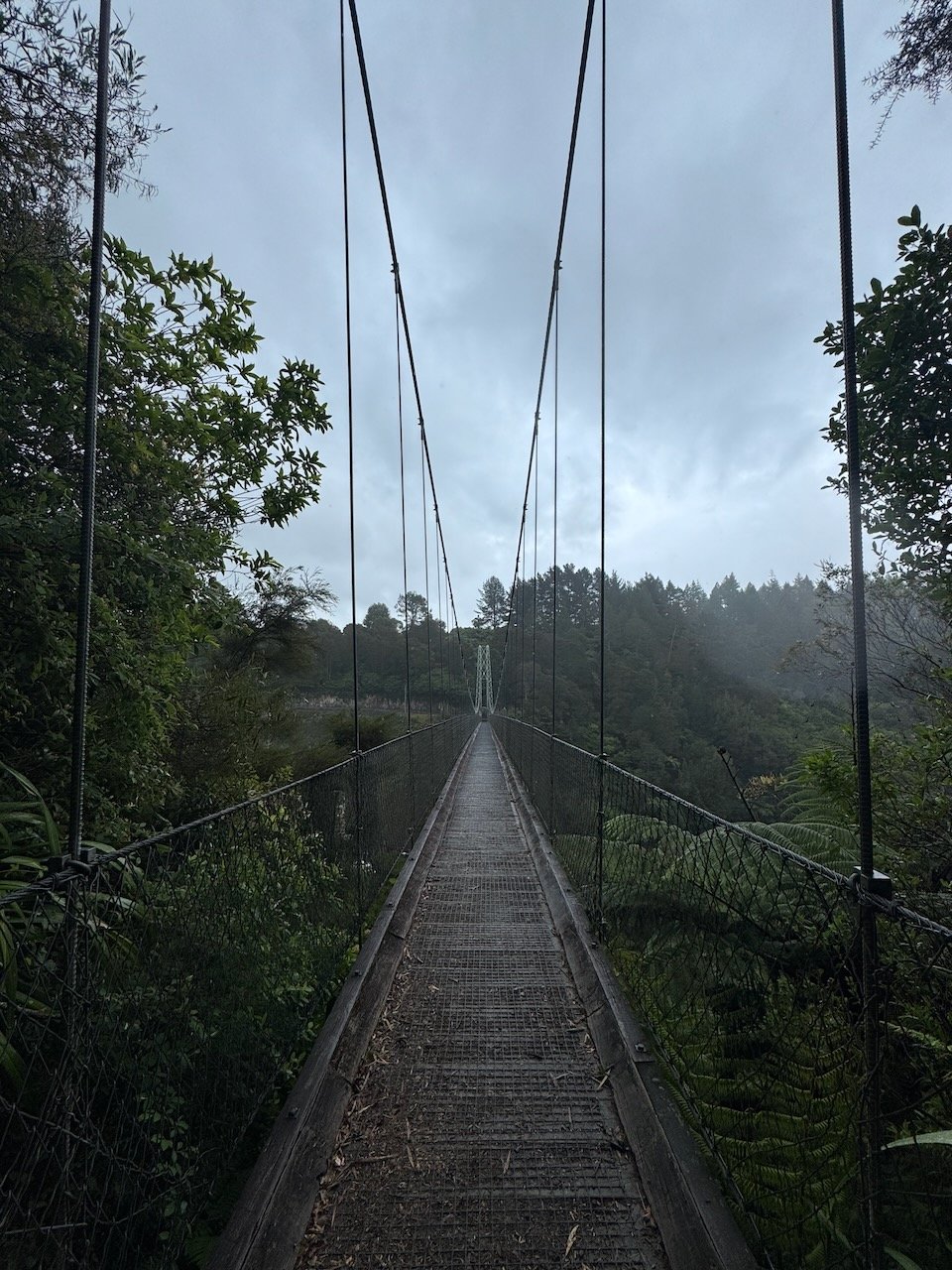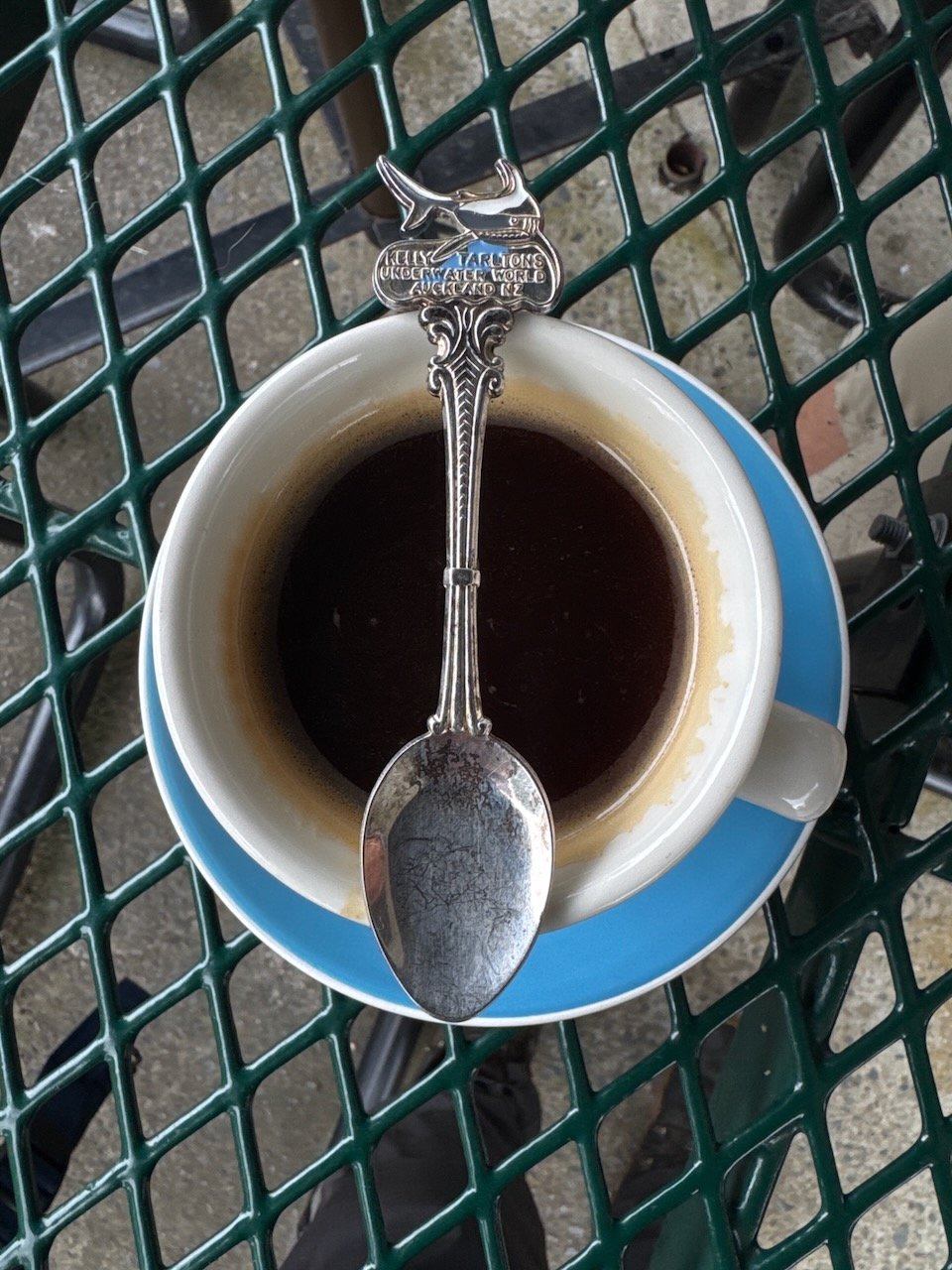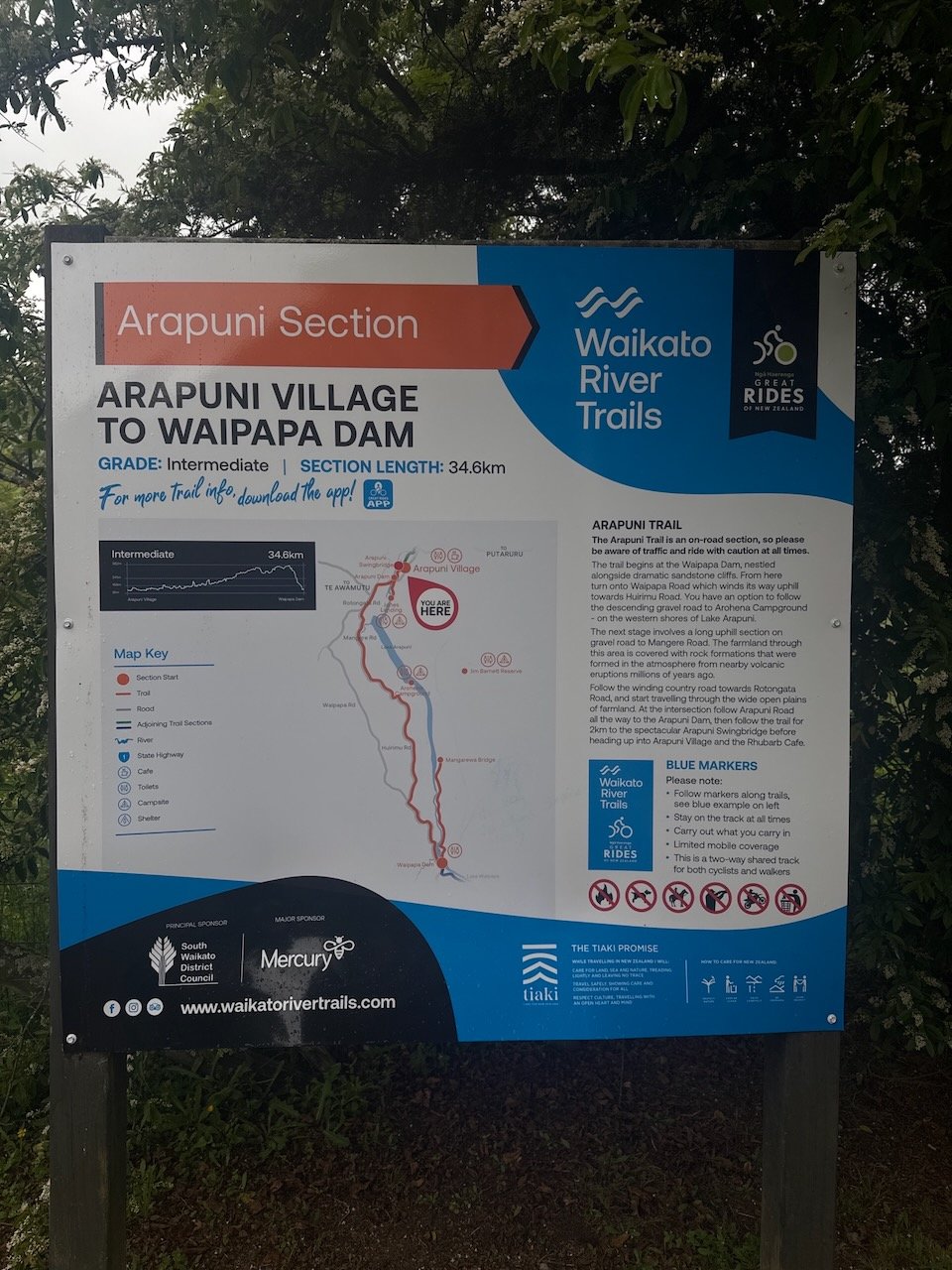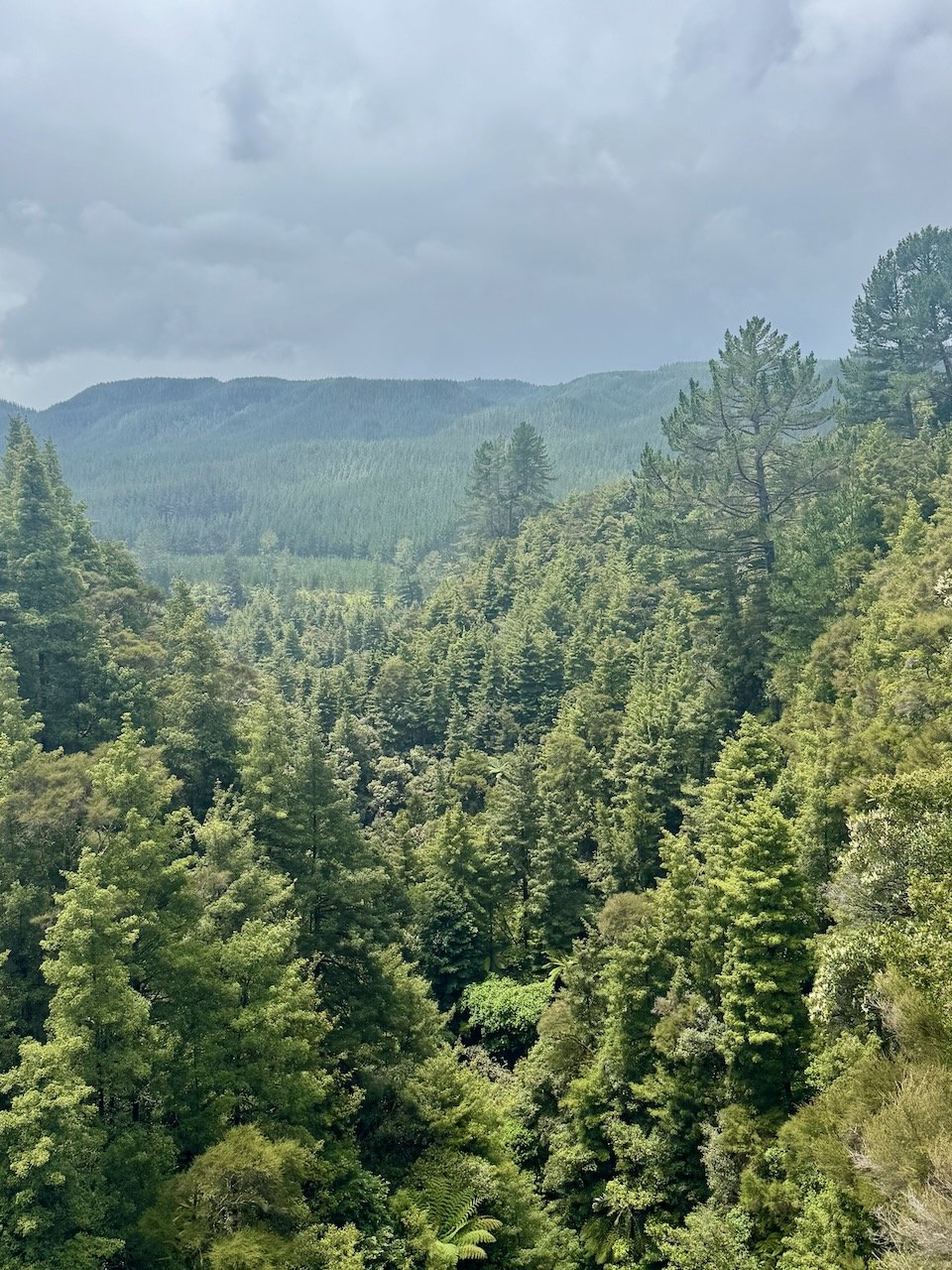Waikato River Trails ~ Nov 19-26, #7
Great Ride to Rough Ride
We rode into Matamata, home to Hobbiton, on the last few kilometers of the Hauraki trail and celebrated in town with a burger, before facing the 30 kilometer ride through the valley mostly on state highways to the start of our next Great Ride along the Waikato River.
In the first few kilometers beyond the edge of town, the amount of traffic dramatically increased disproportionate to the size of our shoulder - meaning there was none. It only took a few more kilometers with livestock trucks and cars whizzing by within inches, for us to both begin eyeing the chunky gravel strip below the raised rail line paralleling the road, thinking - anything is better than this, even for a few more kilometers. And so we veered across the thin strip of grass, to quite happily cruise over chunky rocks and around litter, giving no thought to the fact that we had deplored riding the same chunky gravel on the Hauraki detour just a couple weeks ago. A cyclist’s preferred terrain is definitely all about context, especially when one’s life is literally on “the (white) line”.
Our route then turned on to a less traveled road, giving us a break to enjoy the open countryside, before we had no choice but to return to the state highway. At least this time the shoulder was wide enough to give us a false sense of comfort, until we were faced with navigating a major interchange under construction, leaving us no room between the construction zone and traffic already annoyed by the delays.
A few more kilometers later, we were so relieved to turn off the state highway for good and onto a seemingly peaceful side road following the river that would take us to the start of the trail - that is until, we were stopped not once, but twice, by vehicles coming the other way, telling us there was a very bad accident ahead and the road was partially closed. It was a stark reminder that no roads are safe, especially when the societal norm here is to pass whoever is in front of you, apparently at any cost. We wove through scattered debris, past three destroyed vehicles, amidst people trying to help, hoping that no lives were lost, and more anxious than ever to find our river trail.
Karapiro Section - Waikato River
We pulled into the parking lot at the start of the Karapiro trail just as emergency vehicles whizzed by behind us. Our nerves rattled after our first experience riding the roads of rural New Zealand, we had visions of winding our way along the river’s edge to regain a sense of calm, only to discover within a few hundred meters, the trail left the river to follow alongside the very same road with only a strip of gravel to separate us from the oncoming cars, while a fence line separated us from the cows to our right. I would have preferred it the other way round.
A few more disheartened kilometers later, we spotted what looked like a river-side campground across an open field. Relieved beyond belief, for some reason it hadn’t shown up on any of our camping apps - even better it was free, with showers. We parked ourselves alongside the river at the Little Waipa campground, thankful to be alive, and let the day fade into the sunset.
Despite rain dampening our morning, we were relieved to find from here the trail cut in to actually follow the river all the way to Arapuni Dam. What we didn’t expect, especially on a river trail, were short steep climbs around almost every corner. But then, we remembered, we are in New Zealand, and no longer riding a rail trail.
We passed through a lush wetland at the edge of the river before climbing up to the Arapuni Dam and then felt compelled by the damp to stop at the infamous Rhubarb Cafe to warm ourselves up with the rest of the cyclists/e-bikers oblivious to the weather.
By the time we left the cafe, the clouds were giving way to breaks of blue encouraging us to continue on to the next section of “trail” or so I thought. Our first indication the rest of the trail was not like the last, was contending with our first of the “gates” used throughout many of the Great Ride trails. Clearly, not designed with fully loaded touring bikes in mind. But Nivaun, forever the engineer, would not be inconvenienced, quickly figuring out, if he lifted the front tire off the ground, and walked the bike through on the rear wheel, the panniers fit neatly under the bars - no disassembly required!
Arapuni Section - Waikato River
The next section of the Waikato River trail, Arapuni, turned out to be a road ride - instead of a trail; across farmland - rather than along the river. Having already ridden a fair share of farmland criss-crossing Victoria as our plans changed, riding through even more farmland here was not high on our list.
But this is New Zealand, and as soon as we crossed the dam, the hills rose up around us draped in a blanket of green, a stream meandered below enveloped in native bush, the wind pushed up the valley, waving through the tall grasses in mesmerizing patterns. We were transfixed.
A few more bends, and volcanic rocks in the form of primeval statues or monuments began popping up on one side, and then the other, adding a whole new dimension to our visual palette. The hill climbs were almost imperceptible as our heads swiveled to and fro enjoying a new compilation of fields, trees, rocks and clouds around every corner. So much so, that I overshot the turn to the only campground along this section, and we had to double-back down a slight incline for a couple kilometers, which Nivaun reminded me, we would have to climb again tomorrow.
In my defense, the turn and subsequent road was not at all what either of us had expected, and the only sign was a well-worn, hand-made wooden sign for “Lake”. After a steep descent down the hill on a gravel road, around a bend, across a stretch of paddock, the road then switched back to an even steeper descent down to the edge of Lake Arapuni. Out-stretched before us was an almost empty Arohena campground, a tiered, wide-open field with only one tent and a car. I couldn’t imagine any other bike-packers would choose to stop here, and then a family of five from Switzerland came rolling down the hill on their touring bikes.
The rain returned overnight and showers taunted us the next morning, traveling up river to unload, every time Nivaun had finished sponging off the tent. After the third attempt to dry the tent, the clouds finally broke up, freeing us to finish packing as we watched the Swiss family begin their climb back up to the road.
After our own arduous ascent, we got back on route just as a young Canadian couple rode by. They were headed to the South Island to find jobs and setup residence, in awe that we were on the other end of the spectrum, riding into our retirement having left job and home behind. We kept them in view for a short while, then caught them again near the top of a hill before they descended out of sight. As we crossed another valley, the rain caught up with us, as did the wind. We were still in the midst of rolling farmland with only an occasional vehicle passing us by from either direction, so when we saw a red van slow down as it approached us with a hand hanging out the window, we wondered what we were going to hear next. Instead it was the Post, hand-delivering granola bars! Apparently in New Zealand it’s not just dogs that get treats from the Mail Lady. We later found out the Canadian couple had told the Mail Lady that we were not far behind, so she saved a couple bars for us.
In the last few kilometers, before turning back onto another main road that would connect us to the next section of trail, the ferocity of the wind and rain was such that we could barely stay upright before turning onto the shoulder - a less than desirable move, but forward was the only option. Little did we know, we were turning left while the wind and rain were headed right.
Within a few kilometers, the sun was out and we were flying down the longest hill of the entire trip (6km, 240m descent) into a beautiful pine forest, crossing over rivers several meters below, feeling as though we had slipped back into one of our own forests of home. At the bottom, we looked out over the lake at Waipapa Dam, marking the end of the Arapuni section.
Waipapa Section - Waikato River
We pulled into the rest stop across the road to scan the Waipapa trail sign’s elevation chart and noticed the rating was no longer Intermediate, but “Advanced”. We debated over whether to take the road the next 20km into Mangakino. As much as we wanted to stay off it, we didn’t want to risk pushing up hills, adding both hours and kilometers, uncertain whether we could find anywhere to wild camp along the trail, especially now that it was mid-afternoon.
As much as we loved being amongst the hills covered in dense forest, we were really missing the convenience of our own national forest’s hiker/biker sites. Thus, we began the climb up from the dam on the trail, as it followed the road, and then left it behind, when it descended into the bush leaving the road side for good.
As we wound our way up out of the gorge, we found ourselves questioning whether we had indeed teleported ourselves back home - the hill sides were patchworks of plantation forests in various states of logging, gone was the native bush alongside the road, instead it was lined in Scotch Bloom, intertwined with endless tangles of Blackberries - any last hopes we had for finding a secluded wild camp somewhere along the road were dashed.
Instead, we settled for a free lake side camp in the local park at Mangakino, with a maximum two night stay. Before long, we were joined by the Canadian couple, another from the UK and one more from the Netherlands, swapping trail stories and travel adventures, until they all departed the next morning continuing on to the start of the Timber Trail. We decided to stay another day and then moved to an Air BnB to wait out the weekend. The email Nivaun had been waiting for had arrived. His camera was finally repaired and on its way to Auckland!














































































